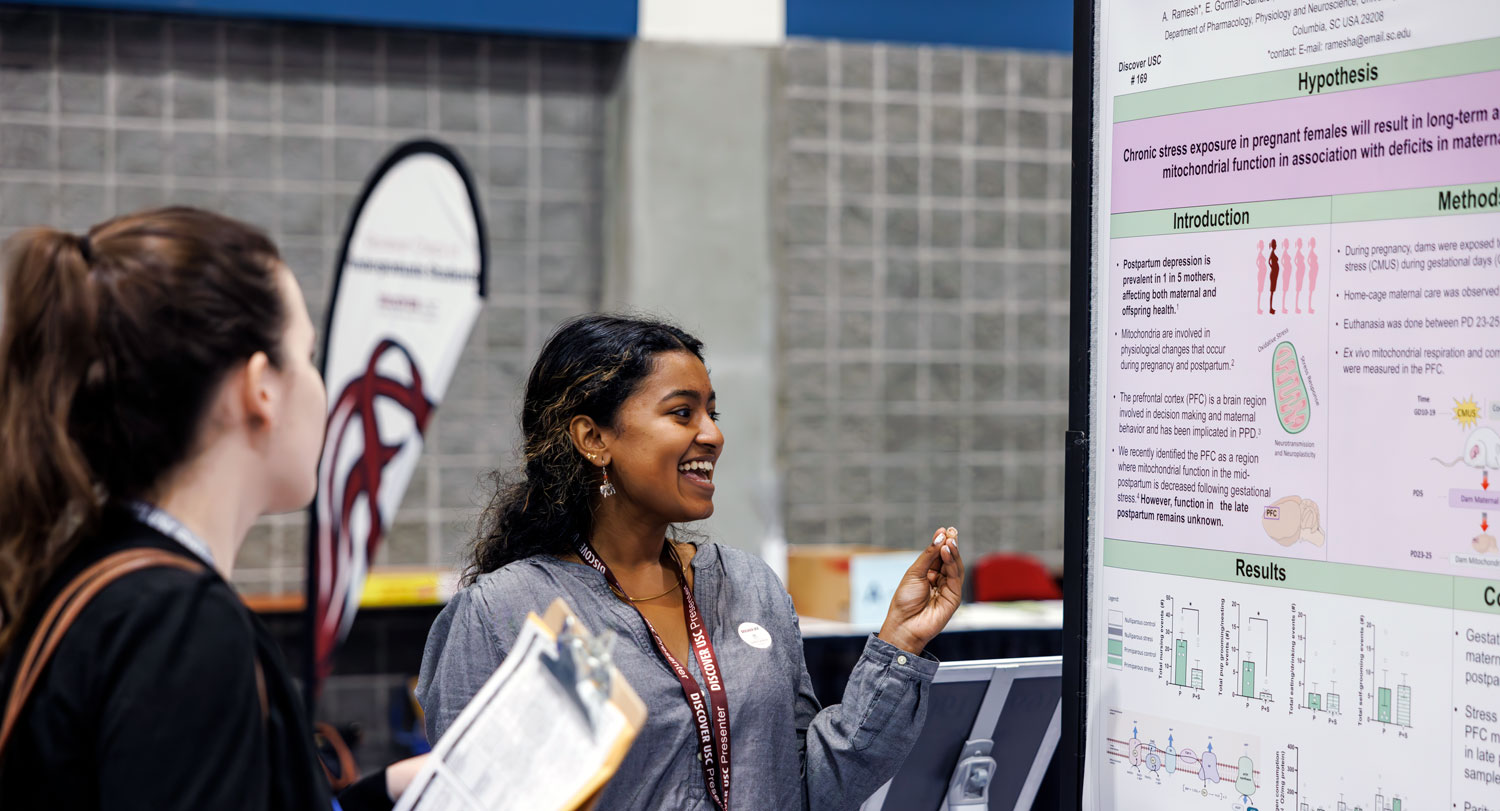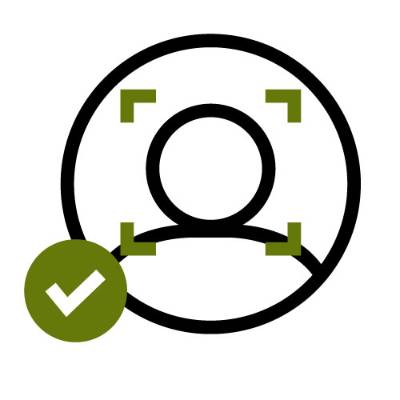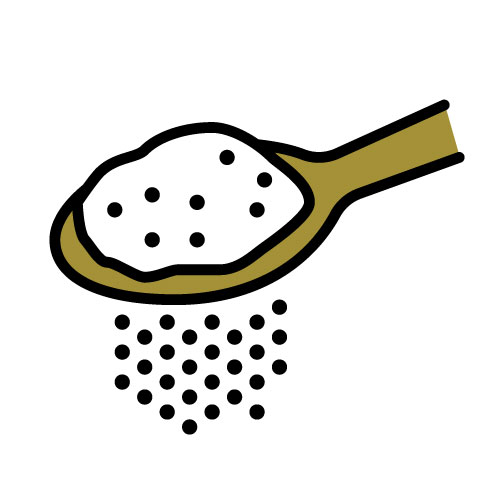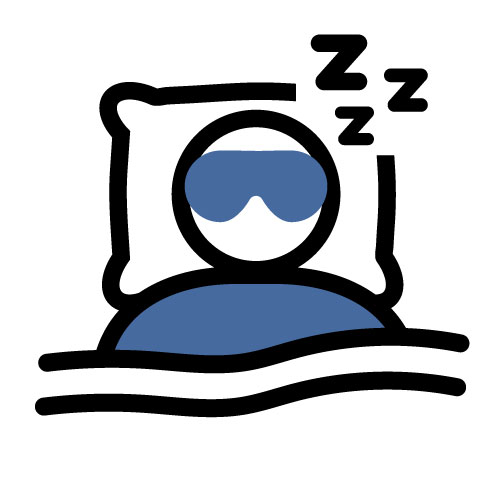
Each year, Discover USC showcases the wide-ranging research being done by University of South Carolina students and postdocs. From health science to humanities and AI to public health, USC scholars — including undergraduate and graduate students, medical scholars and postdocs — are working with faculty mentors and others to explore topics that interest them, learn more about research skills and work on how to present their findings to an audience.
Sponsored by the Office of the Vice President for Research, this year’s Discover USC research projects can be seen throughout the day at the Columbia Metropolitan Convention Center on Friday (April 19). There will be poster presentations at 9:30 a.m. and at 1 p.m., and shuttles will run between the Horseshoe (Sumter Street bus area) and the convention center from 8:30 a.m. to 3:30 p.m. Also, if you are still looking for that elusive selfie with Cocky, stop by between 10 and 11 a.m.
This year, more than 1,100 scholars are taking part in Discover USC. The following are highlights from a few participants' projects, told in their own words.
Chitra Nanda
Public health, sophomore
Research project: “Oral health and recovery in chronic left-hemisphere stroke with aphasia”
Campus: USC Columbia
Hometown: Greenville

Inspiration: I was inspired to do this project through my COMD 500 class, introduction to speech language pathology and audiology, where my professor was a Ph.D. student working in the Aphasia Laboratory. I became intrigued by the subject of aphasia and was able to meet my mentor, Roger Newman-Norland at the Aging Brain Cohort, who was very passionate about connecting oral health with aphasia.
Challenges: My biggest challenges were associated with the data and the interpretation of it. As a public health major on the pre-med route without a background in this area, working with statistics and data can be tricky. I voiced my concerns and confusion to my mentor, who took the time to meet with me and educate me on statistical software and how to generate and comprehend my results. This helped significantly for my presentation and poster preparation.
Lessons: Through this project, I was able to learn about aphasia and how oral health can be a determining factor in brain health and recovery. We discovered a noticeable difference between chronic and acute aphasia patients, with significant results related to the effects of oral health on acute aphasia patients. This is important as our data is localized to South Carolina and highlights how social determinants of health can affect how much access patients have to certain oral health or stroke recovery treatments.
Tyson Ansani
Public health, senior
Research project: “Does co-sleeping with a dog influence dog owners’ sleep quality or physical activity
levels?”
Campus: USC Columbia
Hometown: Columbia

Inspiration: As I caught up with a friend over coffee, they observed that they slept with their dog regularly — but some nights were peaceful, while others left them feeling groggy and unrested. Intrigued by their experience, I delved into sleep research to uncover the potential influence of co-sleeping with dogs on both sleep quality and physical activity levels of their owners. Motivated by the prevalence of dog ownership in the U.S. — where about 50 percent of the population owns dogs, with half of them sleeping alongside their pets — I was fueled by curiosity and a desire to shed light on the often-overlooked aspects of human-animal co-sleeping within the realm of sleep research.
Challenges: Managing recruitment logistics and ensuring data integrity were two significant challenges. One hurdle arose when internet bots completed our research survey, resulting in invalid data. Thankfully, Katherine DeVivo — a graduate student, co-author and mentor — played a crucial role in devising a firewall to prevent bot interference and clean the data. During the data analysis phase, my faculty mentor Christine Pellegrini proved invaluable in deciphering results and drawing meaningful conclusions. The collective support of mentors, colleagues and the research team played a vital role in overcoming obstacles and achieving the study’s objectives.
Lessons: On a lighter note, my research unveiled an unexpected finding: I discovered that co-sleeping with a dog doesn’t notably impact owners’ physical activity levels, but it does lead to significantly worse sleep efficiency (the percentage of time spent asleep while in bed) compared to non-co-sleepers. So, if you’re aiming for more restful nights, you might reconsider sharing your bed with your furry friend. This discovery offers fresh insights into human-animal co-sleeping dynamics and its impact on sleep quality, benefiting researchers and pet owners. These experiences have enriched my understanding of sleep research and equipped me with essential skills for my academic and professional journey ahead.
Maggie Johnson
Neuroscience with a minor in dance, junior
Research project: “Do I know you? Brain responses to familiar and AI-generated faces”
Campus: USC Columbia
Hometown: North Augusta, South Carolina
Inspiration: I’ve been part of fascinating neuroscience research in the Brain Research Across Development Lab with principal investigator Caitlin Hudac for about two years. Earlier this year, Professor Hudac asked me if I would make a database of faces for an upcoming study about brain responses to familiar and unfamiliar faces. Because I had a growing interest in AI and its rapidly evolving capabilities with facial generation, I suggested we use AI to generate some of the facial images, and she agreed. We used two different AI programs; one to generate doppelgängers of familiar faces that participants submitted, the other to find celebrity lookalikes of the submitted photos. Rather than this being a task that I felt assigned to do, I was inspired to combine my two passionate interests about AI and neuroscience together into this project.

Challenges: One of the hardest parts was recruiting participants. It was becoming clear that I may not be able to conduct the research in time for upcoming conferences, but the wonderful people I work with stepped in by arranging for other undergrads in the lab to participate in the experiment. Nearly everyone in the lab volunteered to participate, and I am extremely grateful for this assistance.
Lessons: Without going into too much neuroscience jargon, we found that there was a difference in how brain waves changed between viewing the face of a friend versus the face of someone less familiar and/or not known personally (a stranger, a celebrity or an AI-generated stranger). There was also a difference in how the brain processed real and AI faces, but it is possible that the more significant factor was how familiar the faces were, since familiarity played such a strong role in the different levels of processing. This is important when considering the new social role AI is taking, with artificial friends and realistically generated videos of real people becoming available. If familiarity with a person is more important than if an image depicts a real person, then AI could develop a more social role in our day-to-day lives.
"Rather than this being a task that I felt assigned to do, I was inspired to combine my two passionate interests about AI and neuroscience together into this project."
Michael Greene
Political science, senior
Project: “Overlooked partisans: How to measure rurality, and who are the rural Democrats?”
Campus: USC Columbia
Hometown: Centennial, Colorado
Inspiration: I was initially inspired to do this project by the waves of media articles describing ‘the rural person.’ I thought that the simple picture painted of conservative Americans was lacking nuance and there is a larger story to be told. Upon diving into the literature in academia, I ran into another aspect of the situation: The manner in which we measure rurality is lacking key data. These two themes have kept me motivated to pursue this project.

Challenges: When entering into data collection, I struggled to understand and utilize the data program R to properly weigh my large survey dataset. Lunz Trujillo, assistant professor of political science, helped me. In general, the political science department here at USC has outstanding academics who are interested in rural politics. Professor Darmofal proved to be helpful during the earlier research phase in finding books that relate to the political behavior in rural politics. Professor Thompson, as my thesis advisor, has helped ensure that this project has kept a steady course.
Lessons: The most striking finding is the large percentage of women among rural Democrats. This gender gap has gone largely assumed, rather than measured, so this research fills a gap in the field of rural politics. It is important to study people for who they are and to remind ourselves these large datasets are not just numbers; they are individual voices calling out to be heard.
Sophie Conrad
English and media arts, senior
Research project: “The media as both enemy and ally of the Iran women’s movement”
Campus: USC Columbia
Hometown: Greer, South Carolina
Inspiration: After witnessing the power of the media in activism movements throughout the past decade, I began to wonder about the relationship between the media and the movements that take place in areas that are not often featured in Western media and face censorship issues at the hands of their state. This line of thinking led me to investigate the media as both an enemy and an ally of the Iran women’s movement, as I have always been passionate about women’s activism, and I noticed that this movement, in particular, has received very little Western media attention in addition to facing censorship within Iran.

Challenges: There was not a lot of readily accessible information regarding the media censorship imposed upon the Iran women’s movement at the time I was conducting research. One of my former professors, Dovilé Daveluy of the ESCE International Business School in Paris, directed me to compare and analyze media produced by the Islamic Republic of Iran and content produced by outside media outlets covering the same topic to gauge the variation in coverage and analyze that variation.
Lessons: The media is often seen as a tool for advancing social/activist movements. When it does perform that function, which is relatively often, it is a great resource for movement supporters. However, the media is also often weaponized against social movements by spreading misinformation or by minimizing coverage of important movements in favor of movements that appeal to content consumers and, therefore, generate more income. In the case of the Iran women’s movement, the Islamic Republic of Iran has both distributed misinformation and blocked the movement’s participants’ access to media through censorship policies and internet blackouts, while Western media coverage of the movement has been minimal, contributing to the movement’s difficulties in spreading awareness and promoting change in Iran.
Kari Hill
Public health with a minor in medical health humanities, senior
Research project: “Assessing dollar store food environments in alignment to nutrition support programs
in the Lowcountry”
Campus: USC Beaufort
Hometown: Malvern, Iowa
Inspiration: My journey was ignited by exploring the theme of health inequalities in several of my academic courses. While I had always been aware of the pervasive issue of poverty, these classes cast it in a refreshingly illuminating light, prompting deep and introspective reflection. This academic inquiry stirred a desire to contribute meaningfully to the world — to extend a hand and offer a voice to communities that are all too often silenced or overlooked. I yearned to be a part of the solution, to leverage my research as a platform for amplifying the voices of the underserved.

Challenges: As a dedicated mother to two vibrant children and a full-time college student, the most formidable challenge was the sheer amount of time required. The endeavor was further complicated by my inexperience in the realm of research. This project marked my inaugural voyage into academic investigation, a journey both daunting and exhilarating in equal measure.
My extraordinary mentor, Hadis Dastgerdizad Elyaderani, has given unwavering guidance and encouragement, transforming this rigorous academic endeavor into a journey of immense personal and professional growth. Through her mentorship, I have not only navigated the complexities of this project but have also embarked on a profound journey of learning and discovery.
Lessons: I’ve come to understand the profound challenges faced by those living in poverty, including the impacts of dollar stores on their lives and communities. While these stores may offer immediate financial relief through low-cost goods, they often contribute to long-term health and economic drawbacks in the communities they serve. Dollar stores, by focusing on inexpensive and often less nutritious food options, can undermine the health of individuals and families reliant on them for groceries. Moreover, their presence can stifle local economic development by displacing independent retailers, limiting the diversity of available goods, and providing fewer, often lower-quality jobs compared to local businesses. This reality underscores the importance of advocating for and implementing policies that protect and uplift underprivileged communities.
"This project marked my inaugural voyage into academic investigation, a journey both daunting and exhilarating in equal measure."
MacKenzie Wicker
History, sophomore
Project: “How did the desire for sugar transform labor and create new industries in Caribbean
colonies?”
Campus: USC Columbia
Hometown: Chesapeake, Virginia
Inspiration: I was inspired in my “Caribbean Race and Slavery: 1500-1900” history class to learn more about the use of sugar within the Caribbean colonies and how it created one of the first large-scale industries in the world — both in slavery and in sugar, as they worked interdependently. It shows how all of Europe was willing to ignore morality in order to fulfill a taste for sugar.

Challenges: I struggled with finding credible primary sources that were easy to read. As many of these sources are hundreds of years old, it was hard to find sources that were both useful and easy to understand. It was also hard to read some sources because of the way that language has changed over time.
Lessons: This topic is so important in understanding slavery and why it was able to happen. It shows that morality was disregarded because a group of people wanted something so badly. It is also important history to examine to understand how industry has evolved throughout the years. This was one of the first large-scale industries, and it had great effects on people.
Maarya Khan
Public health with a minor in psychology, freshman
Research project: “Love-Brain: The effect of sleep quality on relationship quality, as measured by
couples’ performance in charades”
Campus: USC Columbia
Hometown: Columbia
Inspiration: I was inspired to work on “Love-Brain” because of my interest in neuroscience. I’ve always found the topic of human relationships fascinating on a psychological level.

Challenges: In this project, we cover sleep studies, qualitative relationship surveys and accuracy in charades, hypothesizing that if there is a positive correlation between sleep and relationship quality, then there would be an improvement in couples’ performance in charades. Over the course of the few months I have been working on the project, I found it difficult to find correlations and explain my research because of all the components involved. I was able to overcome these challenges with my lab coordinators and my fellow researchers. We worked through challenges and maintained an amazing relationship with another through it all.
Lessons: Sleep has a lot of effects on our everyday lives. For example, sleep affects the way you communicate with others, relationships, and performance in academics, fitness and productivity overall. This may seem like a given, but looking at sleep from a psychological and neurological perspective really changes the way you perceive the value of sleep quality as a whole.
Anna Chupak
Health promotion, education and behavior, second-year doctoral candidate
Research project: “Identifying disparities in the relationship between neighborhood walkability and
active transportation safety within South Carolina”
Campus: USC Columbia
Hometown: Old Saybrook, Connecticut
Inspiration: Pedestrian and bicyclist crashes have significantly increased over the last decade, especially within the Southeastern U.S. and within disadvantaged communities, such as among ethnic and racial minorities, low-income neighborhoods, and aging populations. Thus, pedestrians’ and bicyclists’ heightened risk of accidents and death, and related disparities in crashes, are greatly concerning. Further, unsafe environments act as barriers to active transportation like walking and bicycling, thereby reducing physical activity, and exacerbating chronic diseases like obesity. The built environment impacts health and well-being of individuals and communities. Therefore, I sought to investigate the relationship between walkable/bikeable infrastructure supports and pedestrian/cyclist crashes in South Carolina.

Challenges: I experienced most of my challenges during the data analysis process, such as determining the best statistical techniques for examining the relationship between neighborhood walkability and the severity/prevalence of active transportation crashes. For example, I faced difficulties when combining various datasets, dealing with missing data and using new statistical software, such as geographic information systems (ArcGIS) to map my findings across South Carolina. My research advisor, Andrew Kaczynski, and teammates from the BEACH (Built Environment and Community Health) Laboratory, supported my research efforts and helped me address these challenges.
Lessons: First, I learned that poor infrastructure for walking and bicycling may significantly increase the prevalence and severity of crashes within South Carolinian communities. Second, I discovered that the most socially vulnerable neighborhoods were lacking the necessary infrastructure supports for active transportation and had the greatest number and most severe crashes. Third, improvements in neighborhood walkability have the potential to significantly reduce pedestrian and bicyclist crashes in the most socially vulnerable neighborhoods.